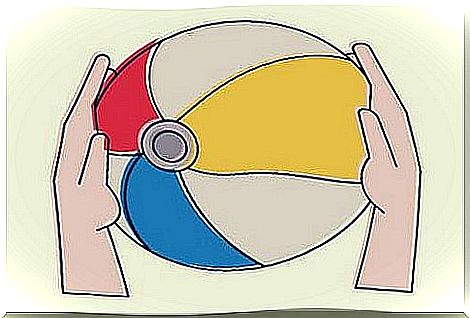The Beach Ball Metaphor For Emotional Regulation

The beach ball metaphor is very useful for emotional regulation, especially anxiety. It is a visualization strategy that also involves some creativity. This is because everyone handles things differently, and this exercise highlights this fact.
In order to evaluate the relevance of these tools to the practicing psychologist, it is important to first understand what we mean by “therapeutic metaphors”. There are a number of stories or rhetorical situations that allow patients to discover a relationship between the beginner concept and a kind of related personal reality.
One of the most well-known therapeutic metaphors is the quicksand metaphor. The goal is to help patients understand that the more you fight a problem, the longer you will sink. Often the solution lies in meeting what you have avoided.
These thought exercises require a number of psychological processes that are very useful during the therapeutic process. First, the patient must understand the metaphor. Then they have to identify with it. After that, they make a connection between what the metaphor explains and what happens to them. Last but not least, the patient must think of a strategy that will help them in their personal life based on the metaphor presented by the psychologist.
The psychologist must take on the role of facilitator and let the patient solve the challenge that the exercise presents.

Emotional regulation: What is the metaphor of the beach ball?
For the beach ball metaphor to be effective, it is wise to talk about visualization. As psychologists McCurry and Hayes explained in their study ” Clinical and experimental perspectives on metaphorical talk”, creating mental images helps patients remember the metaphors later. That way, they can use them when they need them.
Let’s see what this exercise is about.
Visualize the following situation in your mind…
You’re on the beach. It’s a perfectly sunny day. Every part of this perfect scene is saturated with light. However, you do not feel well. You are anxious and your feelings are everywhere. They are swirled together and swirl around in an almost painful way. You feel scared, ashamed, anxious and angry.
- This whole emotional universe is in a beach ball. This object symbolizes all the emotions you feel. They bother you so much that all you want to do is get rid of them. So what are you doing? You go out into the water and try to sink the ball.
- Visualize this scenario in detail. Imagine trying to sink the beach ball. You do not want anyone to see or notice it. You just want it to go away forever. You want the ocean current to sweep it away and never be seen again. But every time you push it under, it reappears to the surface. The more you try to sink it, the harder it reappears. It can even hit you on the way back out of the water and knock you off balance.
How can you solve this problem?
The next step in the metaphor requires some effort. As we mentioned at the beginning of the article , you need some creativity for this part of the exercise. In order to come up with a better solution, remember these factors:
- The ball symbolizes feelings, anxiety, fear, anger and shame, which you have hidden for a long time. However, you are aware of the consequences of keeping them inside.
- So what solution would you offer this metaphorical dilemma?

The most appropriate response is to stop trying to sink the ball. Stop wasting your energy on an impossible task. Hiding your feelings simply does not work. Trying to force them down only exacerbates the problem.
Instead, take the ball, sit quietly on the beach and empty it. Let all the air go out. Once you have done that, you will feel so much better. You will feel relieved. To do so, however, you need to know where the valve is.
Here, the metaphor of the beach ball helps each individual to find their unique strategy to get rid of anxiety, fear and shame. Finding the “mechanism” that helps you understand why you feel the way you do will make it easier to free yourself from these feelings.
While this is not easy, this metaphor of emotional regulation serves to remind you that trying to hide your feelings is like trying to keep a beach ball under water. It simply does not work. The healthy approach is instead to accept, understand and let go of your emotions.









